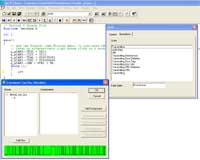
|
Home Contact | |
|
|
|
CROSSWARE ADDS CAN CONTROLLER SIMULATION TO ARM® DEVELOPMENT SUITE
Click on image to enlarge CAMBRIDGE, UK, October 5, 2006, - Crossware (www.crossware.com), a leading embedded software tools developer, has enhanced its ARM Development Suite to enable simulation of CAN (controller area network) controller peripherals of NXP Semiconductors’ (formerly Philips Semiconductors) LPC2119, LPC2129 and LPC2194 microprocessors. The Crossware ARM Development Suite simulates all aspects of a CAN controller and generates a stream of output bits. This bit stream is transferred to a simulating CAN bus where it is merged with the bit streams of other simulating CAN controllers. The merged bit stream is reflected back to all CAN controllers allowing each to win or lose arbitration, transmit and receive data, provide a signal acknowledgement or error status etc. The Crossware Code Creation Wizards will create code for the CAN controllers as well as for the acceptance filter, message identifiers, message data etc. Using these wizards, code to transmit a message and receive a message can be generated in minutes without a single line of code having to be manually written. The program can then be built and seconds later the developer can see the transmitted message appearing on the simulating CAN bus and being received and acknowledged by the receiver. The Crossware suite is simple and easy to use and abstracts the developer from the complexity of the CAN bus code. The graphical interfaces of both the simulating CAN controller and the simulating CAN bus provides visual verification which is both useful as proof of activity and for educational purposes. The LPC2119, LPC2129 and LPC2194 chips, based upon the ARM7TDMI-S processor core, feature multiple CAN controllers and so it is possible to transmit messages between these CAN controllers via the CAN bus. It is also possible to run multiple simulations on multiple PCs as they can connect to the simulating CAN bus across the LAN and so exchange messages with each other. The CAN bus application itself allows 'components' to be connected to the bus. These components will automatically respond as receivers but can also be configured to transmit predefined messages, and respond to specific received messages. No coding is required, making it easy to set up a complete simulating CAN system. By default, the CAN bus application simulates a single bus. However, it can easily be configured to support additional buses. One CAN controller of a simulating ARM chip can then connect to one bus while another connects to a different bus. This allows the software for a CAN hub to be tested without any hardware. The CAN bus is becoming popular with embedded developers due to its speed, reliability and price/performance and it is particularly well suited to embedded network applications where high-speed communication between multiple microcontrollers is required. The Crossware ARM Development Suite provides a complete and extremely user friendly development environment for the ARM family of microprocessor cores with its advanced C compiler, libraries, wizards, simulator and debugger.
About Crossware (www.crossware.com) Crossware is a leading developer of programmer-friendly C cross compilers and other development tools for embedded systems based on the 8051, ColdFire, ARM, 68000, CPU32 and other chip families. Host environments include Windows 9x, Windows NT, Windows 2000 and Windows XP. The company, founded by Alan Harry in 1984, is headquartered in the UK at Litlington on the outskirts of Cambridge. Crossware’s products are used throughout the world by professional developers, educational establishments and hobbyists.
|
||
